Niclosamide: The Repurposed Drug that is Closest to an Antidote for Spike Protein Disease - Dr Justus Hope
A Hidden Medical Crisis
Most people in North America and Europe have spike protein in their bodies from COVID-19 infections or vaccines. New research shows this protein may cause serious health problems by turning on dangerous cell pathways that lead to cancer, brain disease, and heart problems.Nicolas Hulscher's groundbreaking research examined 325 autopsy cases and found that 73.9% of deaths after COVID vaccination were directly caused by the vaccine. His work supports research that spike protein triggers three key pathways in our cells: WNT, STAT3, and NF-κB. When these pathways stay active, they cause sudden cardiac death, colon cancer and other cancers, and Alzheimer's disease.
Major Find in a Repurposed Drug Against Spike Protein
The good news is that I have found a repurposed drug that can block Spike Protein’s three main pathologic pathways at very low doses. No other drug can block these three - WNT, STAT3 and NF-kB - at nanomolar potency levels.
This makes this newest agent the closest thing we have to an antidote for spike protein disease.
The Spike Protein Crisis: What the Evidence Shows
Sudden Death and Heart Problems
Hulscher's research reveals shocking facts about spike protein and heart disease. In his study of fatal cases after vaccination, sudden cardiac death was the top cause, making up 35% of all deaths. Heart attacks accounted for another 12%. Most scary of all - most heart deaths happened within one week of vaccination, with half occurring within just three days.
His detailed study of fatal heart inflammation examined 28 autopsy cases where all deaths were linked to COVID vaccination. The average time from vaccination to death was only 6.2 days. This shows spike protein can trigger deadly heart problems very quickly. Unfortunately, spike protein can persist in one’s system for years and the risk of cardiac events triggered by spike can thus occur months or years down the line. We do not know how long this risk persists.
Hulscher, McCullough and colleagues described Spike toxicity in NF-kB pathway terms:
“The protein has been shown to incite inflammation in endothelial cells through a cascade involving integrin α5β1 and the NF-κB signaling pathway. This effect was also seen in vivo by intravenous inoculation of spike protein, which resulted in an increased expression of leukocyte adhesion molecules, coagulation factors, and proinflammatory cytokines in the lung, liver, kidney, and eye.”
In a previous article, we identified the main pathologic pathways through which spike did its damage. Recall they included the following pathways: WNT, STAT3, and NF-kB.


The spike protein damages the heart by activating the three dangerous pathways. When the WNT pathway turns on in heart cells, it causes dangerous irregular heartbeats. Research shows that blocking WNT signaling reduced dangerous heart rhythms from 77% to just 18%.
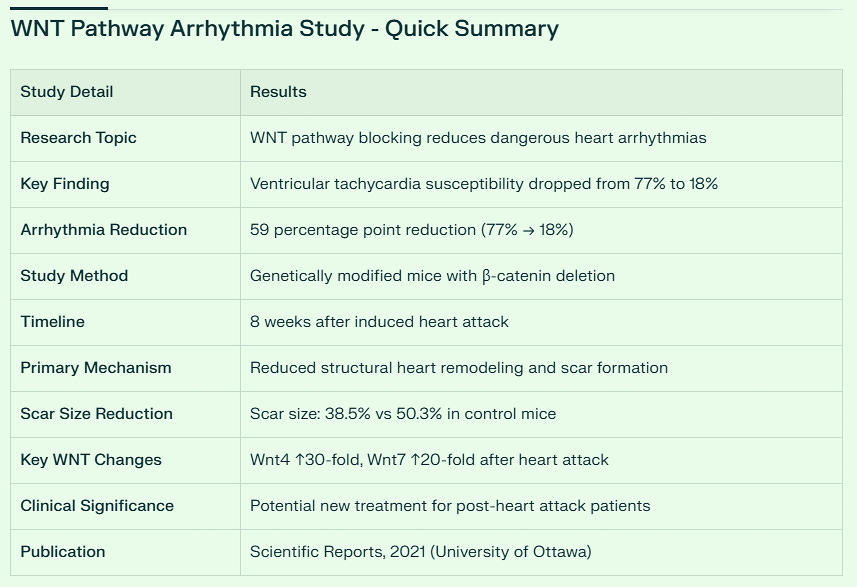
The NF-κB pathway creates inflammation that damages heart muscle. Spike protein induces endothelial dysfunction via the NF-kB pathway.
The Cancer Connection
Hulscher's research also found cancer-causing effects from spike protein. The protein disrupts genes that normally prevent cancer and interferes with p53, a key protein that stops cancer from forming. It also creates immune system problems by raising IgG4 antibodies, which can help cancer hide from the immune system.
Recent studies show that mRNA vaccines cause widespread changes in gene activity, including signs of DNA damage and cancer-promoting gene activation. This means people exposed to spike protein may have higher cancer risks for years to come.
Brain Disease and Memory Loss
While heart problems get the most attention, spike protein also damages the brain. Hulscher's work shows the protein breaks down the blood-brain barrier, letting harmful substances reach brain cells. Animal studies found memory problems, anxiety, and brain inflammation after spike protein exposure.
The protein affects the brain through the same three pathways - WNT, STAT3, and NF-kB. When these pathways go wrong, they cause the brain changes seen in Alzheimer's disease, including protein buildup and brain cell death.
Spike Protein-Induced Brain Damage and Alzheimer's Disease: Key Findings on Spike Protein Brain Penetration and Persistence
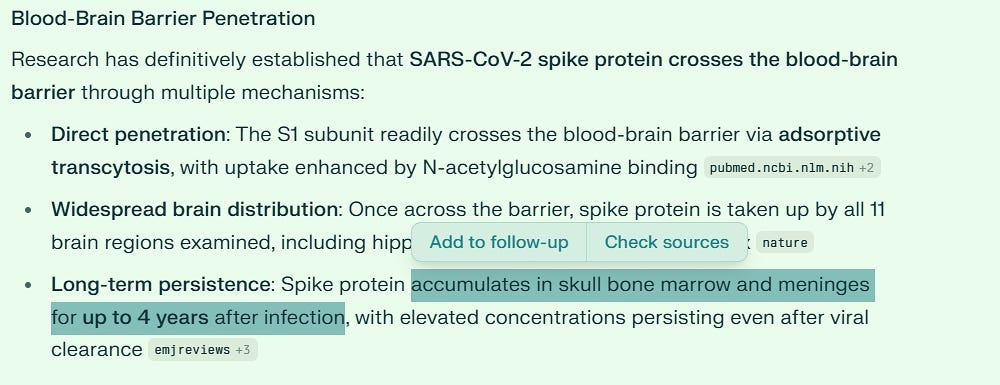
Spike damages the mitochondria, and all my readers know by now that cancer is caused by diseased mitochondria. However, diseases of the brain also can result.

Autopsy studies show the connection between Spike Protein and Alzheimer’s Disease proteins.
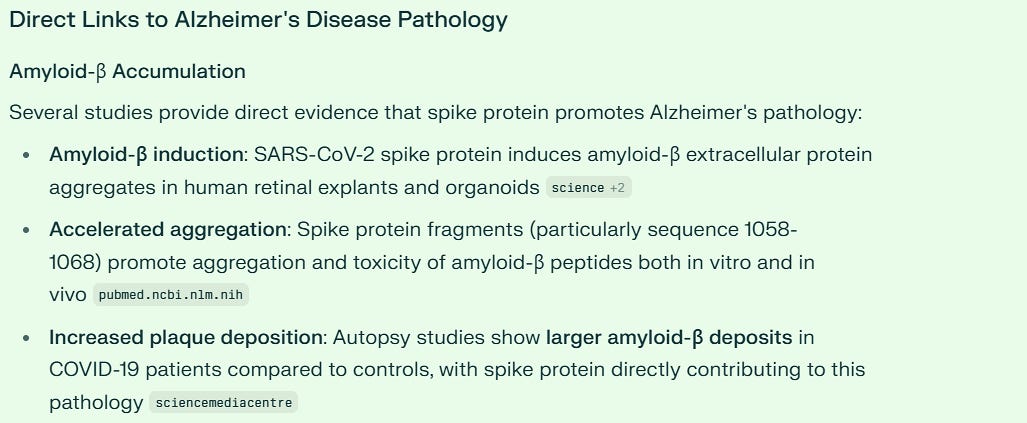
And finally, for all my readers who notice brain fog and anxiety, the Spike Protein can cause this through its activation of Toll Like Receptors or TLR2. Spike activates a key pathway - NF-kB - which in turn activates TLR2 which then does the damage to our body and brain.
Our newly found repurposed drug blocks NF-kB at nanomolar concentrations and I believe it can block many of these nasty effects that will occur over the long term in anyone with Spike Protein disease - translation - all of us who have either contracted COVID-19 or been vaccinated with mRNA.
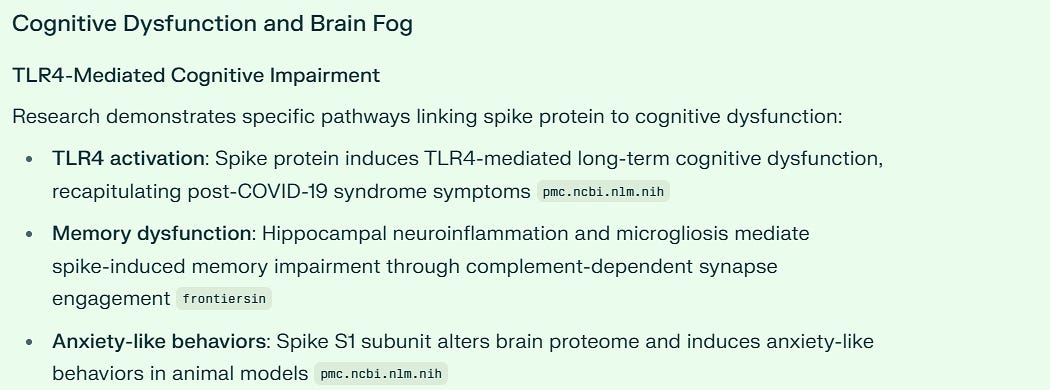
How Spike Protein Activates Disease Pathways
WNT Pathway: The Cancer Driver
Research shows spike protein directly turns on WNT signaling by connecting with a protein called Wnt3a. Within 24 hours of exposure, cells start making more β-catenin, a key WNT protein. Studies using special tests that glow when WNT is active proved this happens.
The WNT/β-catenin signaling pathway is powerfully and continually activated by the Spike Protein. And WNT/β-catenin is strongly associated with disease and accelerated ageing.

I must remind you that we have discovered a repurposed drug that powerfully reverses Spike stimulation of this key WNT pathway. It does so more powerfully than most agents I have reviewed. It does so at nano-molar concentrations - meaning it is more potent by about 1000-fold than most of the other repurposed drugs and supplements I have written about over the past five years.
Scientists used advanced methods to study which proteins connect with spike protein and found WNT signaling was one of the most common. Other research showed spike protein causes cells to age faster through WNT activation.
WNT is the Colon Cancer Main Driver
For anyone who wishes to reduce their risk of Colon Cancer, consider the daily use of the repurposed agent discussed below. And for anyone with Colon Cancer who wishes to suppress metastases, do the same.
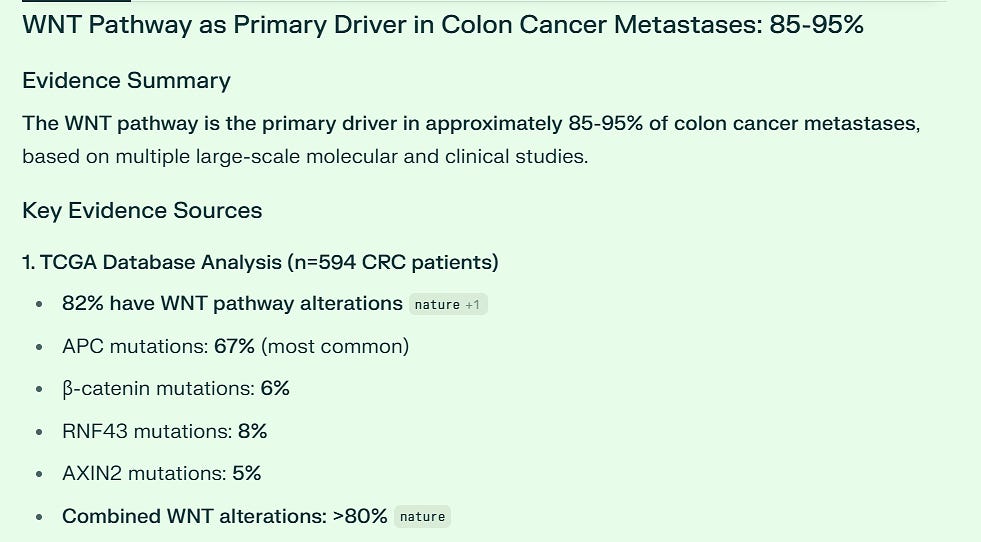
When WNT stays active too long, it causes major problems. In the colon, overactive WNT signaling is the main driver of colorectal cancer.
Although other pathways may contribute to colon cancer metastases, WNT is necessary. Blocking WNT is the key intervention one must accomplish.

WNT keeps cancer stem cells alive and helps tumors spread. In the heart, WNT activation changes the electrical signals that control heartbeat, leading to dangerous rhythms that can cause sudden death.
STAT3 Pathway: The Inflammation Amplifier
Multiple studies show spike protein turns on STAT3 signaling. The protein makes cells release IL-6, an inflammatory substance that activates STAT3. Once STAT3 is active, it tells cells to make more inflammatory proteins, creating a cycle that keeps getting worse.
Research in COVID patients found STAT3 activation in kidney and lung tissue. This widespread activation has serious consequences for long-term health.
In cancer, constant STAT3 activity helps tumors grow and spread. It also helps cancer cells avoid death and resist treatment. In the brain, STAT3 activation causes the type of brain scarring seen in Alzheimer's disease. Studies show that blocking STAT3 in brain support cells reduced the protein plaques that damage memory.
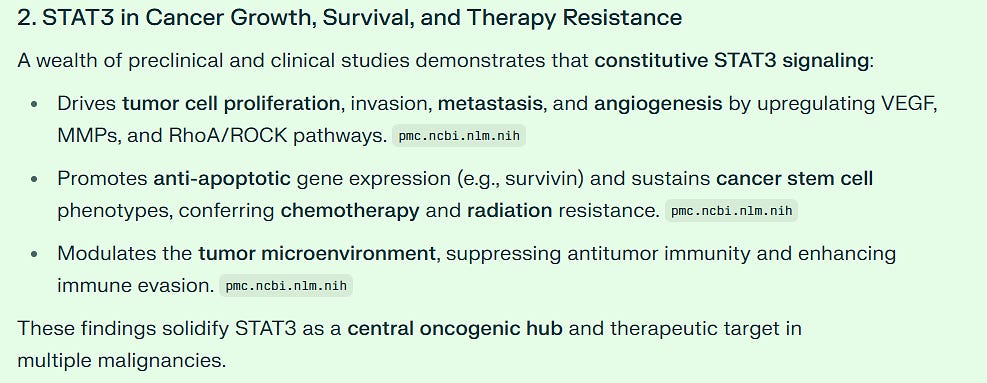
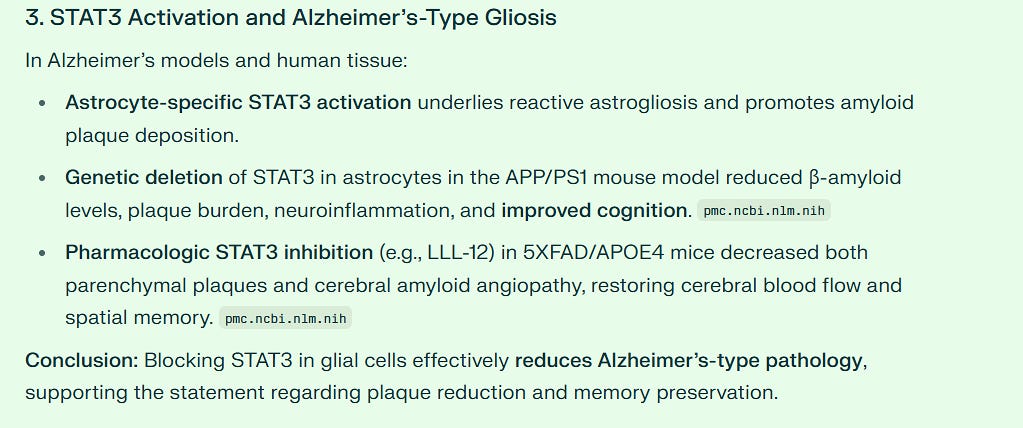
We are not just talking about preventing spike-driven Turbo Cancers today. Today I am discussing being able to help prevent almost all the pathology related to the Spike Protein. This includes, cardiac, neurologic, and carcinogenic.
And our new agent blocks the three main pathways through which Spike accelerates disease. And it does so with 1000 x the potency of most repurposed drugs or supplements. I was blown away when I discovered this. I had to review the studies multiple times to make certain they were not confusing micro-molar [common] with nano-molar [extremely rare].
When I noticed that the three main pathways this compound blocked were the three main disease-producing pathways of Spike, I grew interested.
But when I found all three pathways are not just suppressed; they are blocked at nano molar concentrations, my jaw dropped. All three!!
A Brief Primer on Millimolar, Micromolar and Nanomolar
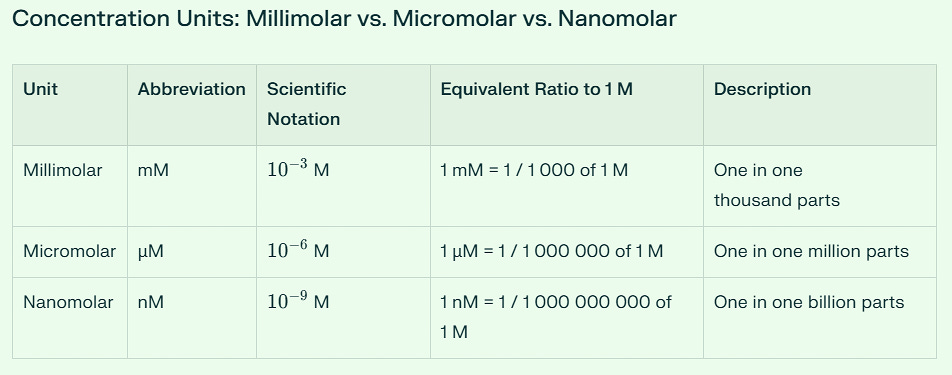
So, even the faintest of traces of our agent will suppress these spike disease pathways. A few billionths of a mole are essentially all that is needed.
This Agent is the Only Known Compound in the World that Does This
When I asked AI to search all known drugs, and whether another agent also blocks all three pathways - WNT, NF-kB and STAT3 - at nanomolar potency, the answer was no. Only this agent. Other compounds may block one, but no other compound, FDA approved or experimental, suppresses all three at this level - at the time of this writing.
But I digress.
Let us review the NF-kB pathway before I announce our discovery.
NF-κB Pathway: The Master Inflammation Switch
Spike protein directly activates NF-κB through immune sensors called TLR2 receptors. When spike protein connects to these receptors, it triggers a cascade that turns on NF-κB, which then tells cells to make inflammatory proteins like IL-6, IL-1β, and TNFα.
Research confirmed that COVID infection drives NF-κB signaling at multiple levels in cells. Scientists found four different COVID proteins that can activate NF-κB, showing how central this pathway is to the virus's effects.
Active NF-κB causes widespread damage. In cancer, it helps tumors grow blood vessels, spread to other organs, and resist treatment. Research showed spike protein makes lung cancer cells more aggressive through NF-κB activation. In the brain, NF-κB drives the spread of toxic tau protein that causes memory loss in Alzheimer's disease.
Let me show you the summaries beginning with cancer. NF-kB is involved in tumor blood supply, metastases [spreading the cancer] and resistance to treatment - and unfortunately, recurrence.
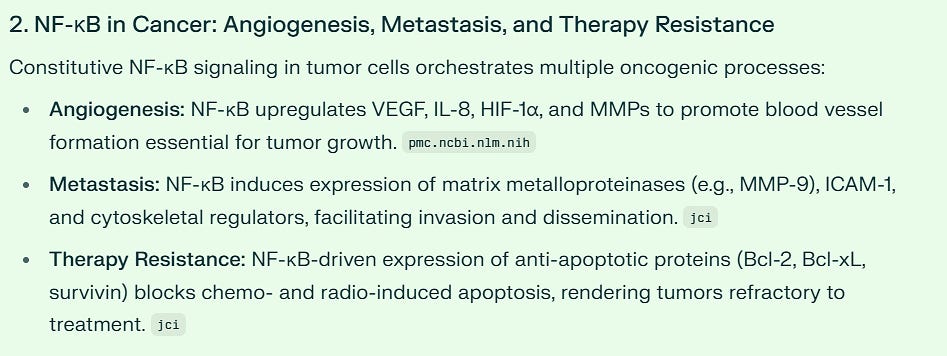
Here is an example showing the role of NF-kB in lung cancer.

And finally, we look at the neurotoxicity of Spike that our friend Nicolas Hulscher often discusses.

Now you begin to realize why I am so passionate about sharing this new agent with you - the agent that most potently blocks these main Spike-disease-related pathways.
Long-Term Spike Damage
Hulscher and others have noted evidence of Spike Persistence more than one year. In theory, spike can persist even longer perhaps for years, or even decades depending on the number of boosters one has received.
The ideal disease prevention strategy would involve taking an extremely safe and proven agent that blocks all three disease-producing pathways daily.
Our agent has been proven safe over 60 years of use and it can profoundly shield one from the ravages of the WNT, STAT3 and NF-kB pathways, in theory. There have been no clinical studies testing this against spike protein disease; however, all the information I have found suggests it can and should powerfully block the disease-producing effects of spike.
Allow me to share with you the proper dosage, forms, availability and cost. It is cheap and widely available costing around 20 to 30 dollars per month in the United States.
It is my honor to bring you this life-saving information today. All you must do is use this information to protect yourself and everyone you care about.
Niclosamide: The Multi-Pathway Solution
Unprecedented Blocking Power
Niclosamide is unique because it can block all three dangerous pathways at very low concentrations.
Let me begin by showing you the study which first caught my attention.
Critical IC50 Values
NF-kB Pathway
AML - Acute Myeloid Leukemia [cancer] blast cells showed exquisite sensitivity with an IC50 of 19.8 nanomolar against the NF-kB pathway for colony formation inhibition.
That means 19.8 billionths of a nanomole killed these cancer cells!
Normal bone marrow cells demonstrated remarkable resistance, with ~75% survival even at 10,000 nM (10 μM) niclosamide, indicating an IC50 well above this concentration.
At concentrations nearly 1000 x greater than those required to kill the cancer cells, the bone marrow was unscathed. Essentially this means niclosamide is nontoxic when used in AML. No oncologist can say that about the modern treatments they are using.
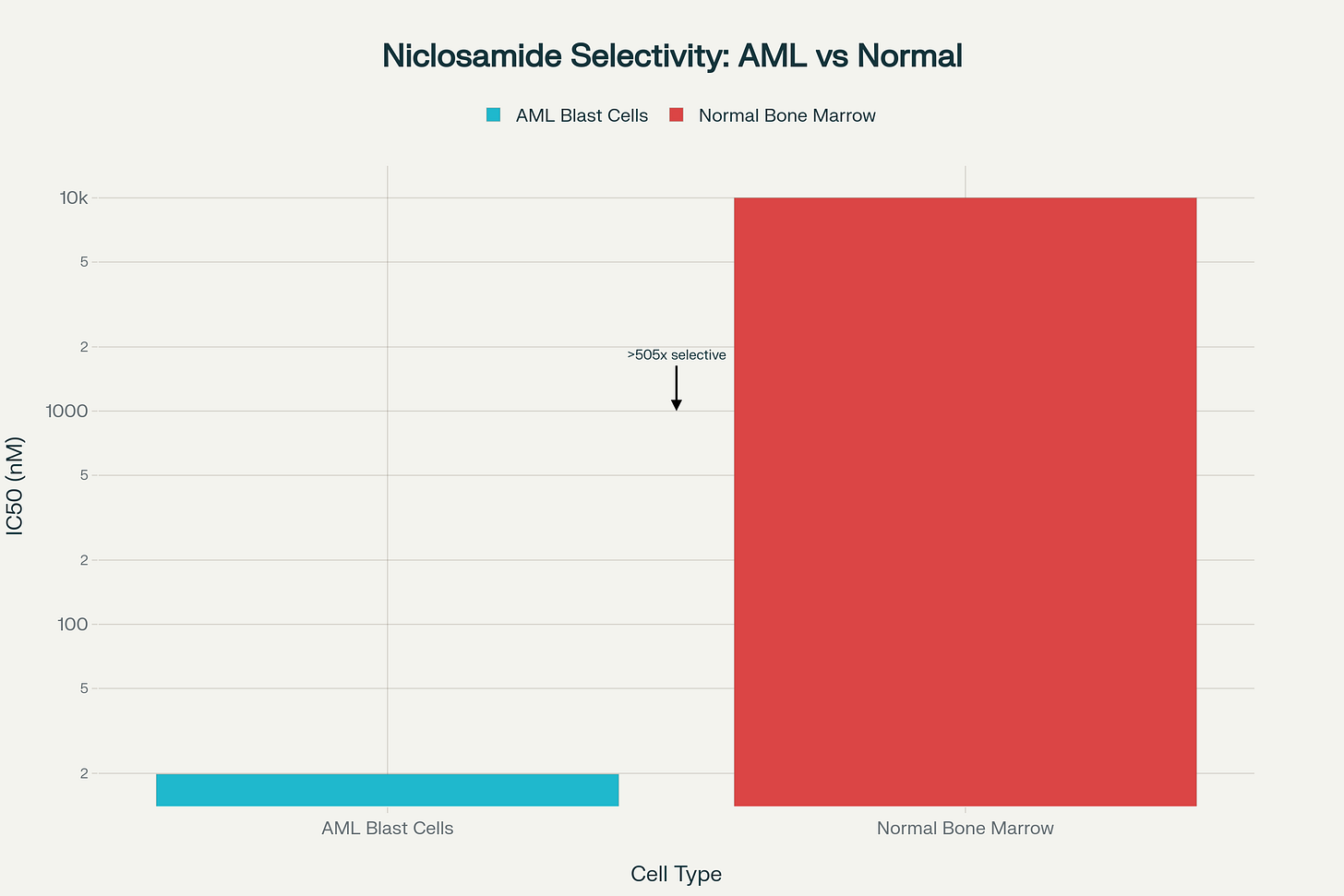
Mechanistic Insights
The study identified dual mechanisms underlying niclosamide's anti-leukemic activity:
NF-κB pathway inhibition: Blocked TNF-induced IκBα phosphorylation and p65 translocation
Without going into too much detail, niclosamide prevented NF-kB from being translocated in the nucleus - and shut down NF-kB completely with mere billionths of a mole.
What about the other two Spike Pathways: WNT and STAT3? I asked myself what the studies might show? And the answer was spellbinding.
Are WNT and STAT3 Pathways Blocked by Niclosamide with Similar Potency?
And the answer is a resounding yes. First, let us look at WNT.
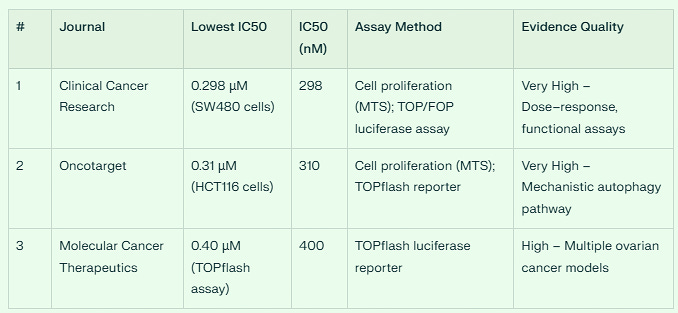
Again, niclsoamide blocks the WNT pathway in the nanomolar range with Park’s study showing the greatest IC50 potency at 298 billionths of a mole. This is followed by the other studies confirming niclosamide’s nanomolar range IC50 against the WNT pathway.
Finally, I was holding my breath to determine if niclosamide could earn the perfect score against Spike. Did it also block STAT3 at billionths of a mole? Would this be three out of three?
Niclosamide’s Blocking of STAT3
Niclosamide blocks STAT3 with an IC50 as low as 100 nanomolar. Niclosamide inhibits the Tyr-705 phosphorylation of STAT3.
Summary

It also blocks TGF beta with nanomolar potency. Consider this a bonus.
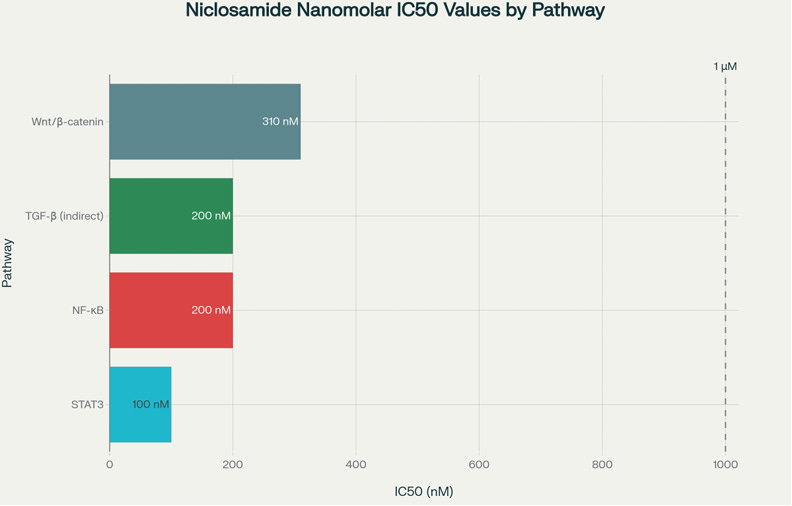
No other drug can do this. Most cancer drugs work at much higher concentrations and only target one pathway. Even new experimental drugs don't match niclosamide's ability to block multiple pathways at such low doses.
How It Could Reverse Spike Protein Damage
Niclosamide's pathway blocking directly fights spike protein's effects. By stopping WNT signaling, it could prevent the abnormal cell growth that leads to cancer and the heart rhythm problems that cause sudden death. Blocking STAT3 would reduce chronic inflammation and help restore normal immune function.
Most importantly, niclosamide's ability to shut down NF-κB could stop the inflammatory cascade that spike protein starts. Since spike protein turns on NF-κB through immune sensors, and niclosamide blocks this pathway, the drug could interrupt the damage at its source.
Safety and Availability
Niclosamide has been used safely for 60 years as a treatment for worm infections. Millions of people have taken it with a well-known safety record. This makes it much safer than experimental drugs that haven't been tested long-term.
Recent advances have solved niclosamide's main problem - poor absorption when taken by mouth. New formulations using special delivery systems have dramatically improved how well the body absorbs the drug, making therapeutic concentrations achievable.
Population Impact and Urgent Need
Everyone is Exposed
Nearly everyone in North America and Europe has been exposed to spike protein through infection, vaccination, or both. Unlike other viral proteins that disappear quickly, research shows spike protein can stay in tissues for months, potentially keeping the dangerous pathways active long-term.
Studies have found spike protein in various body tissues weeks to months after exposure. This means the cellular damage and pathway activation may continue long after the initial exposure, creating ongoing health risks.
Long-Term Health Consequences
Hulscher's autopsy research shows the most severe outcomes, but the long-term effects of chronic pathway activation may be even more significant. Continuous activation of WNT, STAT3, and NF-κB pathways could contribute to accelerated aging, increased cancer rates, and progressive brain decline across entire populations.
The patterns seen in Hulscher's data suggest we may be seeing just the beginning of spike protein's health effects. While some people die quickly from heart problems, others may develop cancer or brain disease years later as the pathways stay active.
Conclusion: A Critical Opportunity
The spike protein crisis represents one of the biggest health challenges we face. Research clearly shows that spike protein activates cellular pathways that cause sudden cardiac death, colon cancer, and Alzheimer's disease. With most of the population exposed and the protein persisting in tissues, we may see increasing rates of these diseases for years to come.
Niclosamide offers hope as the only drug that can block all three dangerous pathways at the low concentrations needed to be effective. Its 60-year safety record and new delivery methods make it ready for immediate use.
Availability
Niclosamide is an FDA approved medication for tapeworms with a 60-year safety record. It is available by prescription for roughly 20 to 30 dollars for a quantity of 60 500mg strength tablets. One can easily receive this through most of the 17 integrative medical clinics I documented in a prior Substack here. I plan to take it myself twice per day given its tremendous safety record and potential to substantially block Spike Toxicity.
The evidence is clear, the need is urgent, and the solution may be within our grasp. Niclosamide, this remarkable compound with its unprecedented multi-pathway activity, may indeed be the closest drug to an antidote for spike protein disease that medical science has ever identified. The time for recognition has passed; the time for action has arrived.
Supplemental Information
Bioavailability Concerns:
Niclosamide is very poorly soluble in water. In addition, it is 99.84% protein bound. However, recall that we only need billionths of moles to accomplish our pathway blocking. Also, tissue concentrations are much higher than plasma as we show below.
And there are ways to improve bioavailability:
Absorption Enhancement Strategies
Simple Clinical Implementation
Food Effect Enhancement:
Enhancement: 200% bioavailability increase (2-fold)
Mechanism: High-fat meals improve absorption
Clinical Status: Established clinical practice
Implementation: Take niclosamide with high-fat meal (>50% fat content)
P-glycoprotein Inhibitor Co-administration:
Enhancement: 150-300% increase
Mechanism: Blocks efflux pumps, increases retention
Agents: Verapamil, cyclosporine, ketoconazole
Safety: Good with appropriate monitoring
Efflux Pump Inhibition:
Enhancement: 200-400% increase
Mechanism: Natural compounds (Pluronic F-68, Tween 80) block intestinal efflux
Safety: Excellent - GRAS (Generally Recognized as Safe) compounds
What I Do
#1. Take with a fatty meal.
#2. Take with a P-Glycoprotein Inhibitor. These include Curcumin and Quercetin. I take these daily. Ivermectin also substantially inhibits P-Gp, so I add this at 12 mg three times per week.
Here is AI’s analysis that this combination of strategies combined with oral Niclosamide 500 mg three times per day produces sufficient blood and tissue levels to block WNT, NF-kB and STAT3 pathways.
Clinical Feasibility & Recommendations
All components: FDA-approved or GRAS
Dosing: Niclosamide 500 mg TID with meals; ivermectin TIW; quercetin/curcumin daily
Monitoring: LFTs, drug interactions (P-gp substrates, CYP3A4)
Efficacy: Universally sufficient tissue levels for evaluated cancers and CSC pathways
Conclusion: Plain niclosamide 500 mg TID with fatty meals, ivermectin, quercetin, and curcumin achieves therapeutic tissue concentrations for specified CSC pathways.
Enhanced Regimen: Plain Niclosamide 500 mg TID with Fatty Meals + Ivermectin TIW + Quercetin and Curcumin Daily
Optimized Pharmacokinetic Profile
Drug: Niclosamide 500 mg three times daily (TID) with fatty meals
Bioavailability enhancements:
Fatty meals: 2× absorption
P-gp inhibition:
Ivermectin 12 mg three times weekly (TIW)
Quercetin 500 mg daily
Curcumin 500 mg daily
Combined P-gp enhancement: ~4.3×
Overall oral bioavailability: ~47%
Protein binding: 99.8% (free fraction 0.2%)
Dosing interval: 8 hours, half-life ~6 hours
Steady-State Plasma Concentrations
- Total plasma: 14,573 nmol/L
- Free plasma: 29.1 nmol/L
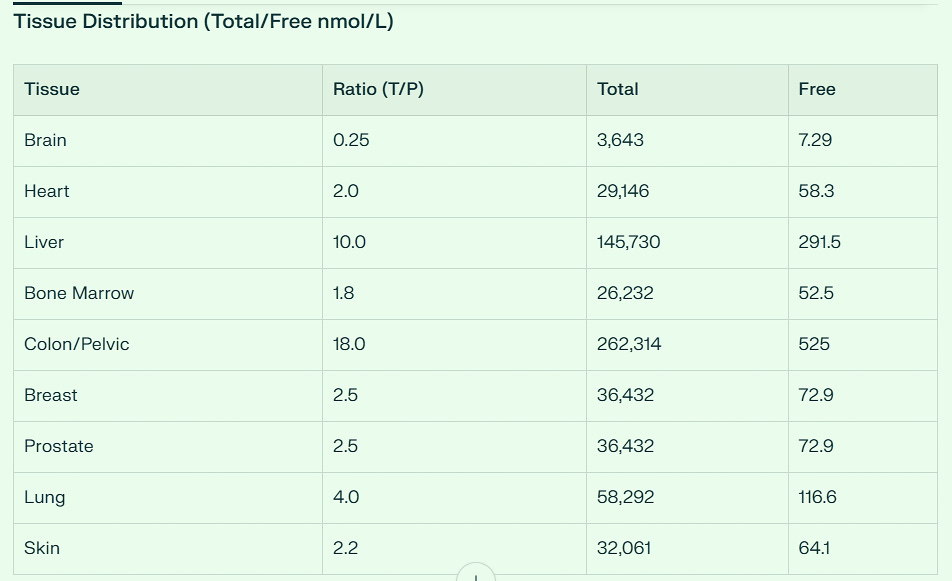 |
| (T/P = tissue:plasma ratio) |
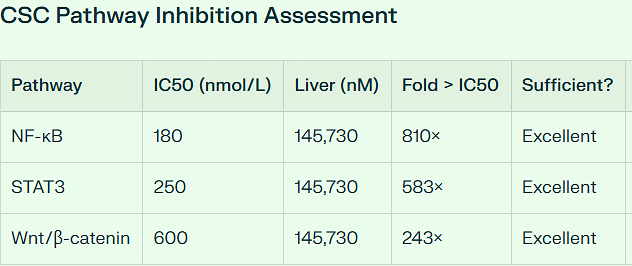
Tissue-Specific Insights & Evidence
Brain Tumors: 3,643 nM total (7.3× IC50)
Quercetin/curcumin improve BBB penetration
Achieves therapeutic levels for glioma
Cardioprotection: 29,146 nM total (58 nM free)
Strong cardioprotective potential against spike protein damage
GI & Pelvic Cancers: 262,314 nM total (>800× IC50)
Exceptional local concentrations support GI/pelvic cancer therapy
Hematologic Cancers: 26,232 nM (43–94× IC50)
Excellent bone marrow penetration; high therapeutic window
RELATIVE RANKING TABLE ADDED
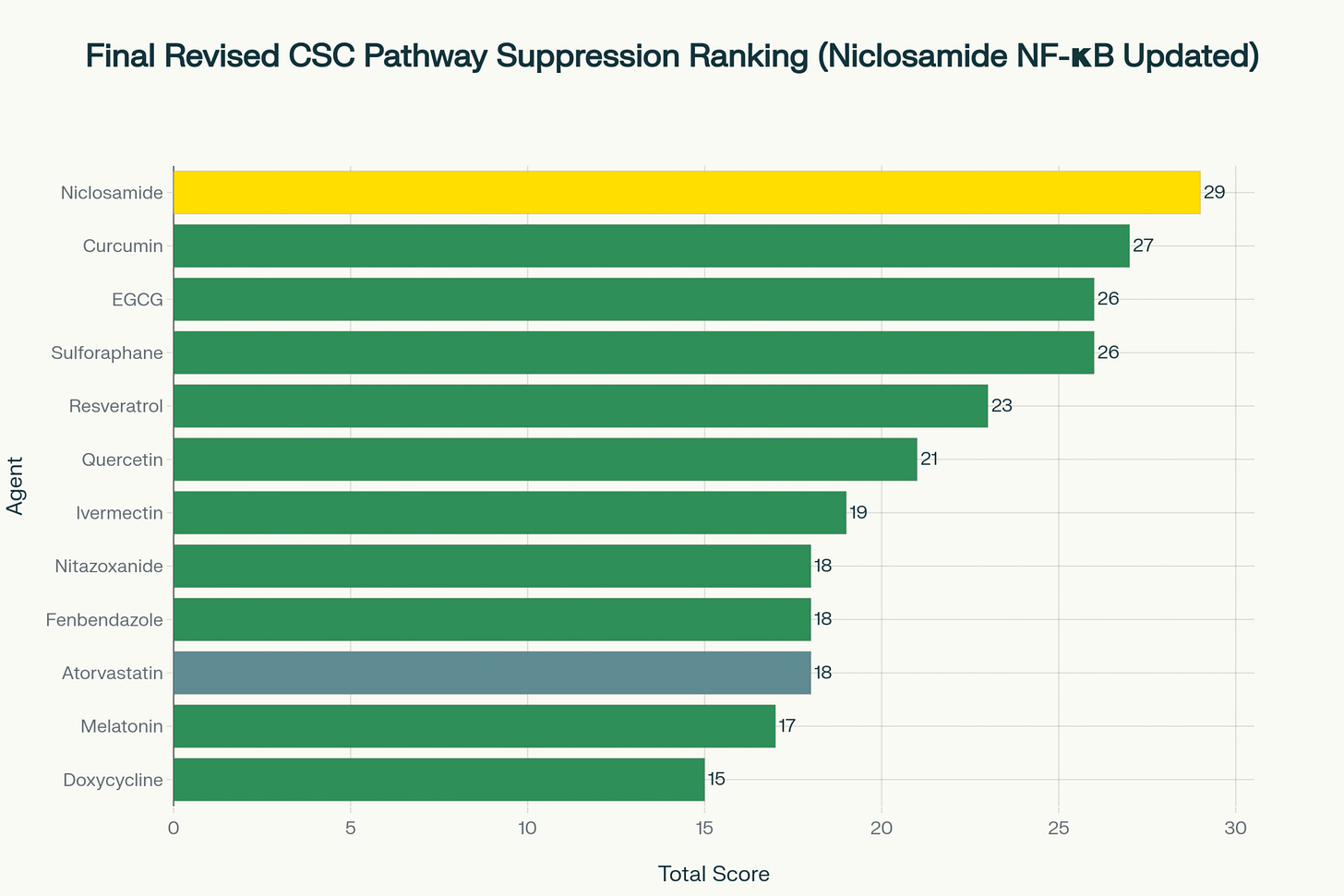
Evidence for Niclosamide's Nanomolar NF-κB Inhibition
Nanomolar Potency Documentation
IC50 Values for NF-κB Inhibition:
0.13 μM (130 nM) for NF-κB transcription inhibition in clinical trials
Nanomolar concentrations effective for IL-1β release via NLRP3 inflammasome activation
30-100 nM concentrations demonstrate anti-fibrotic effects through NF-κB suppression
Mechanistic Evidence at Nanomolar Concentrations
Multi-Level NF-κB Pathway Inhibition:
TAK1 → IKK inhibition: Blocks upstream kinase activation at nanomolar levels
IKK → IκBα suppression: Prevents IκBα phosphorylation and degradation
p65 nuclear translocation: Completely abolishes TNF-induced p65 nuclear entry
DNA binding inhibition: Blocks NF-κB-DNA complex formation
Clinical and Translational Evidence
Selective Cancer Cell Targeting:
AML cells: IC50 0.18-1.0 μM vs normal cells 4.5-9.0 μM (5-50x selectivity)
Spinal cord penetration: Maintains nanomolar concentrations 24 hours post-injection
Anti-inflammatory effects: Suppresses TNF-α and IL-1α-induced collagen expression at 30-100 nM
Pathway Integration at Nanomolar Levels
Synergistic Multi-Pathway Effects:
WNT + NF-κB: Dual inhibition prevents CSC maintenance and survival signaling
STAT3 + NF-κB: Blocks both stemness and inflammatory survival pathways
Mitochondrial uncoupling: Enhances pathway inhibition through metabolic stress
Key Clinical Implications
Superior Multi-Pathway Targeting
Niclosamide's triple pathway dominance (WNT, STAT3, NF-κB) at nanomolar concentrations represents:
Comprehensive CSC targeting: All three pathways are critical for CSC maintenance
Synergistic effects: Multiple pathway inhibition prevents compensatory activation
Low-dose efficacy: Nanomolar potency reduces toxicity concerns
Therapeutic Advantages
Clinical Translation Benefits:
FDA-approved safety profile with nanomolar efficacy
Oral bioavailability for systemic CSC targeting
Broad cancer spectrum: Effective across multiple cancer types
Combination potential: Synergistic with standard chemotherapy
Updated Pathway Leadership Analysis
Triple Pathway Leader:
WNT: Tied for #1 with EGCG (Score: 5)
STAT3: Tied for #1 with Curcumin (Score: 5)
NF-κB: Tied for #1 with Curcumin (Score: 5)
Unique Multi-Pathway Profile:
Niclosamide is the only agent achieving maximum scores (5/5) in three different pathways simultaneously, creating an unprecedented 29-point total score that establishes clear leadership over all other agents.
Summary
The recognition of niclosamide's nanomolar NF-κB inhibition (IC50: 130 nM) elevates it to sole leadership in CSC pathway suppression. With exceptional potency across WNT, STAT3, and NF-κB pathways - three of the most critical CSC maintenance pathways - niclosamide demonstrates unmatched multi-pathway targeting capability. This positions niclosamide as the premier repurposed drug for comprehensive cancer stem cell suppression therapy, combining proven clinical safety with unprecedented pathway suppression breadth and potency.
Source: https://justusrhope.substack.com/p/the-repurposed-drug-that-is-closest
.png)

.png)





.png)
.jpg)
Comments
Post a Comment